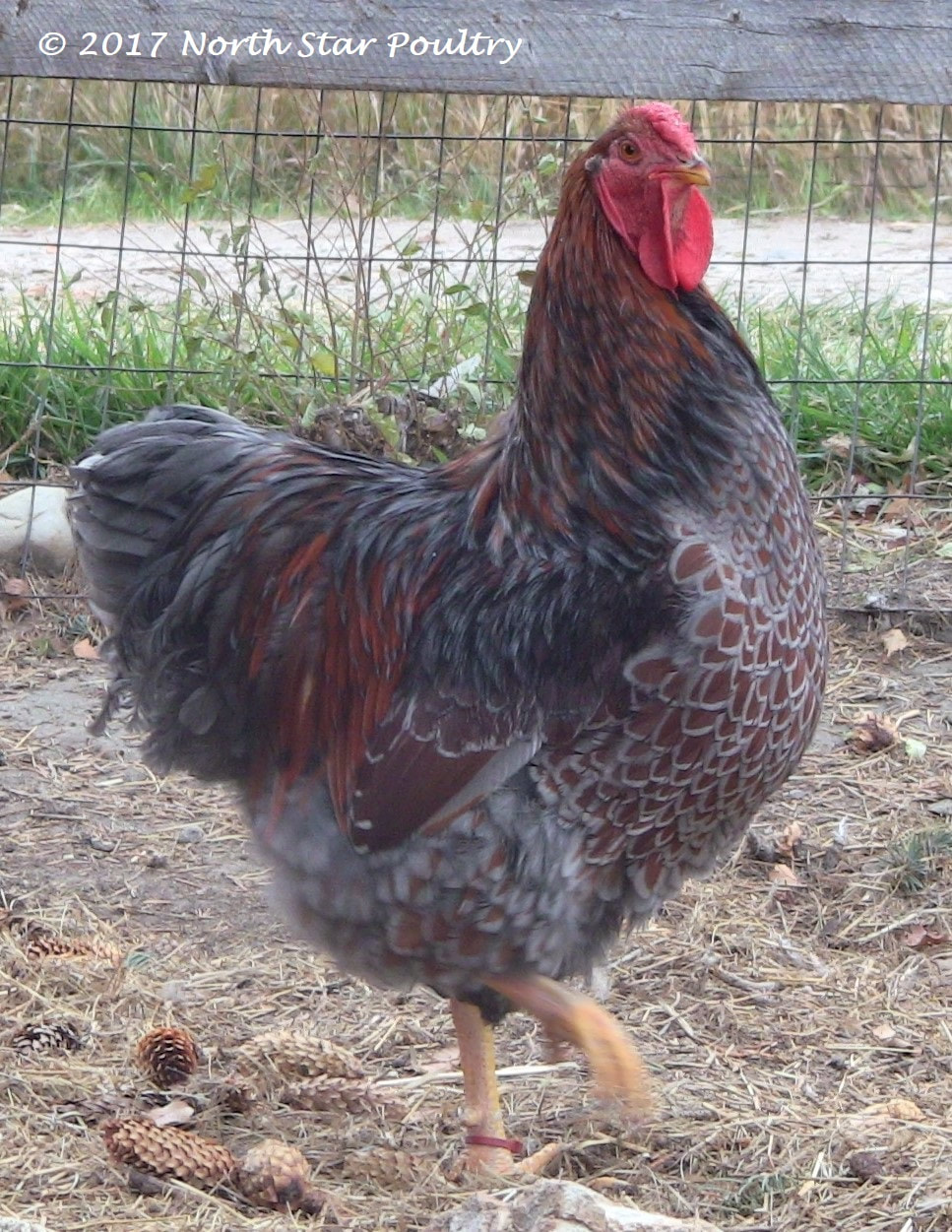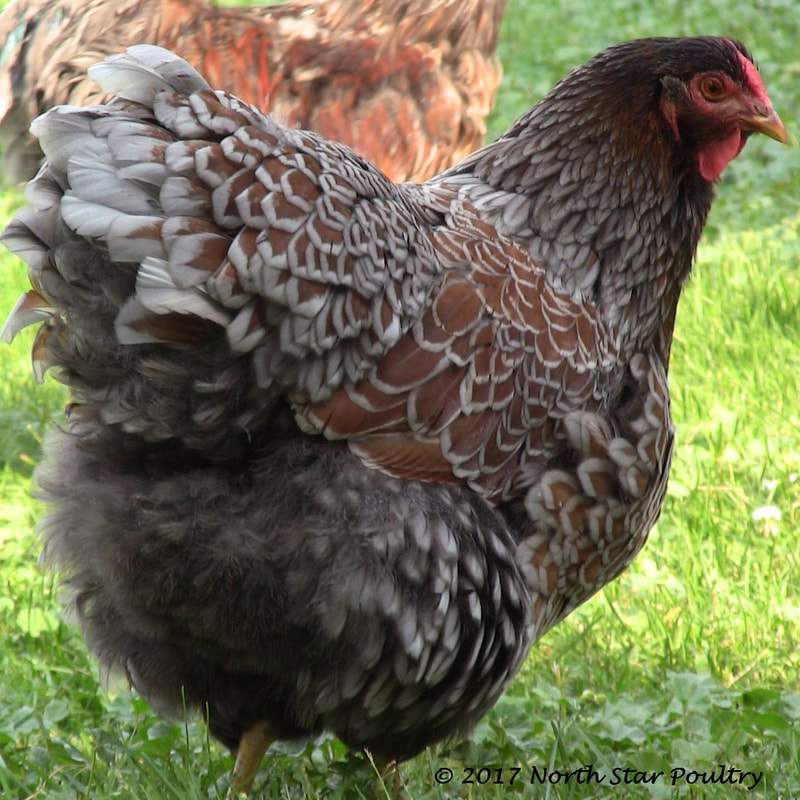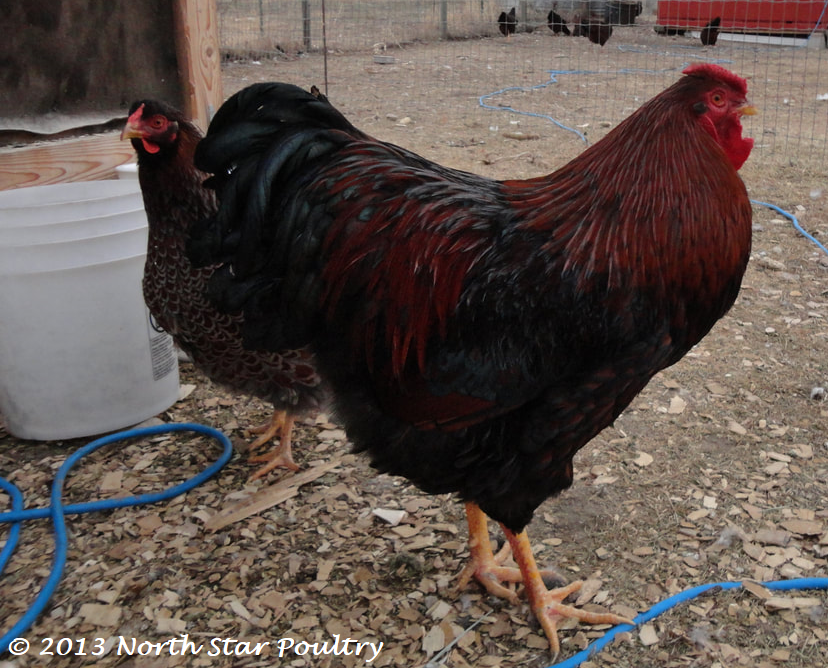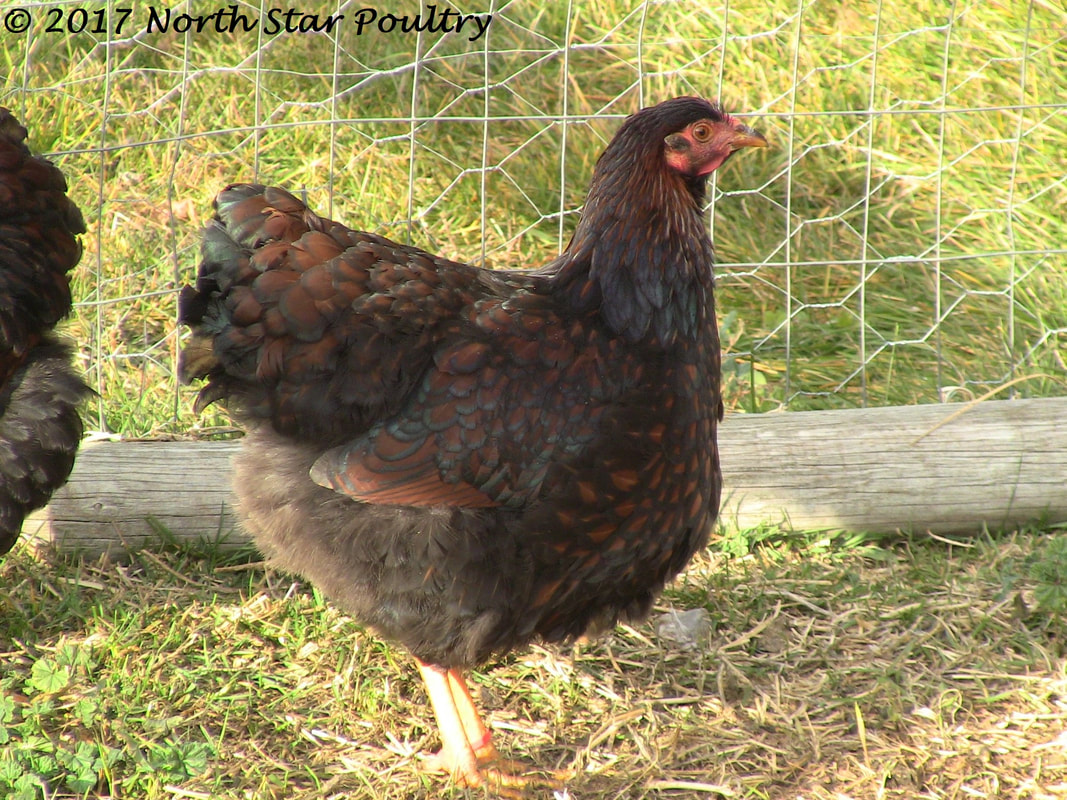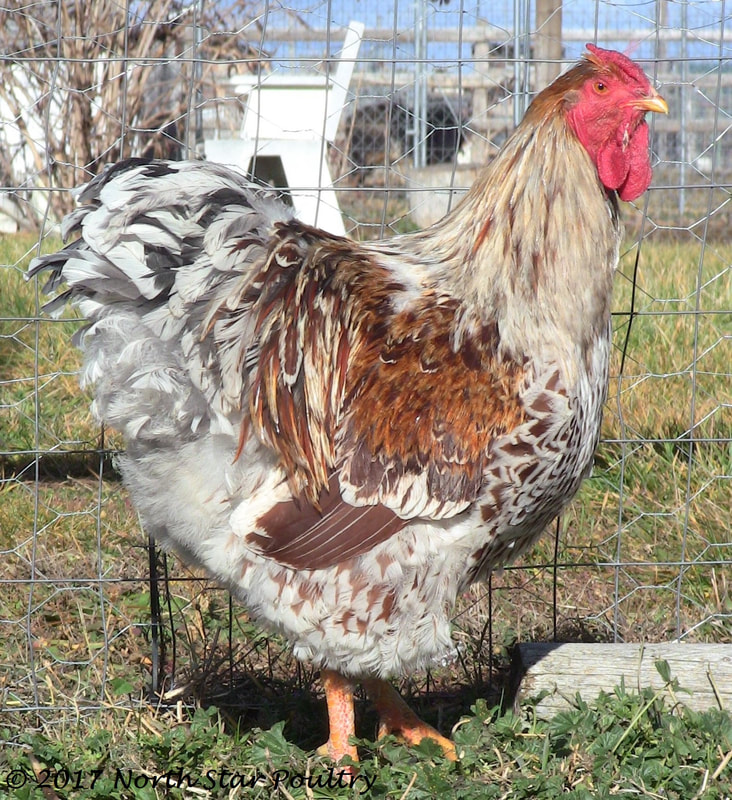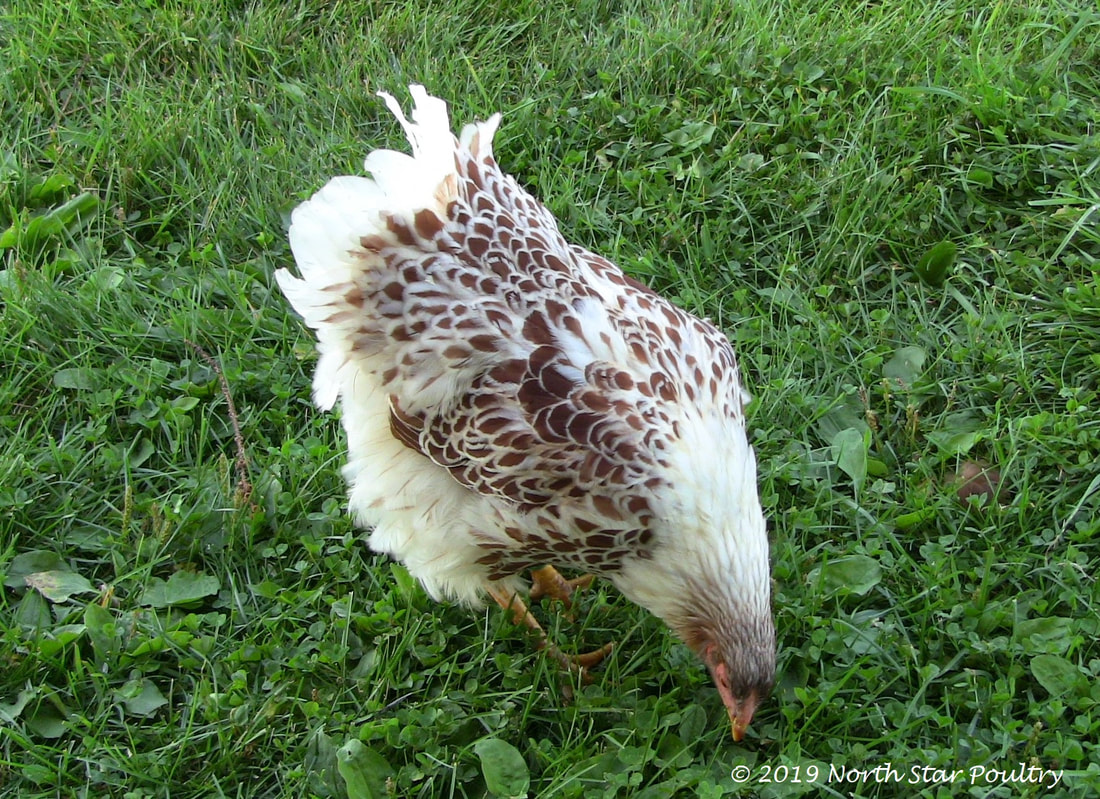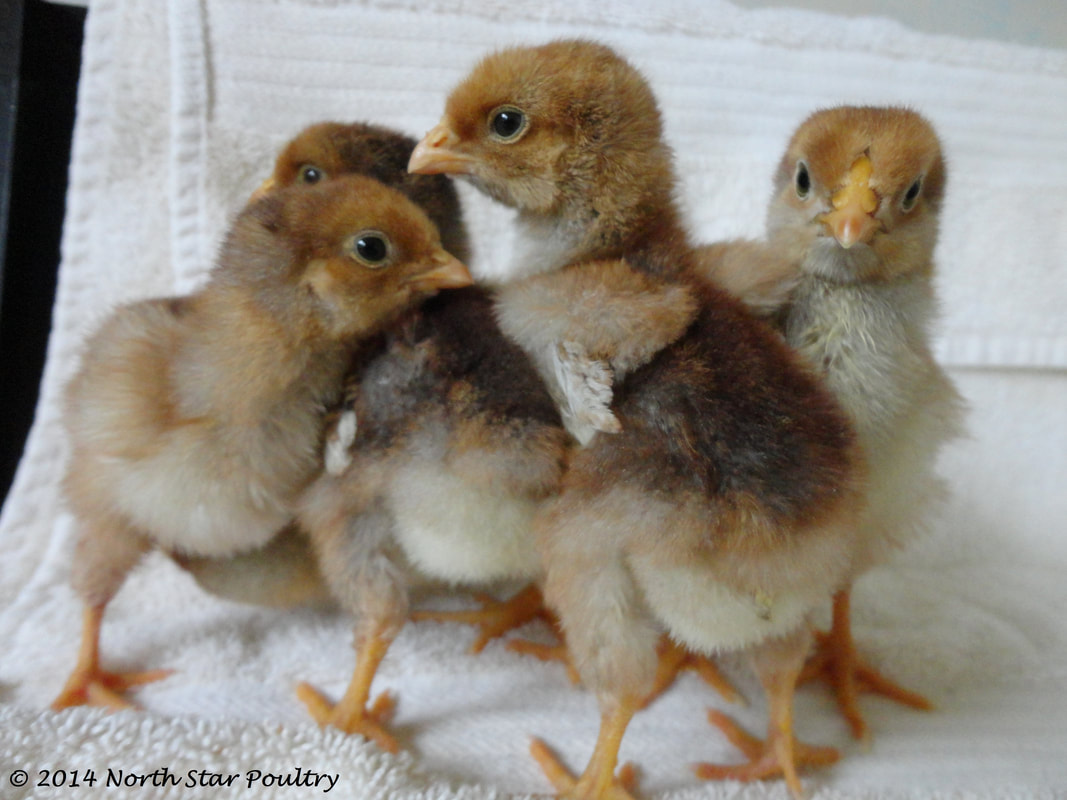*** PLEASE NOTE: We no longer breed Blue Laced Red Wyandottes. This page is for reference purposes only. ***
Blue Laced Red Wyandottes
Questions & Answers
Q: Why are there three different colors of Blue Laced Red Wyandottes?
A: The three different color phases are caused by the Andalusian blue gene. All three colors are the same breed, the Blue Laced Red Wyandotte--it's just how it works with Andalusian blue.
A chicken has two copies of each gene, one copy inherited from each parent. There are various forms of these gene copies that cause different outward effects. Andalusian blue chickens are basically a black chicken with a "lightening" factor. By luck of the genetic draw, a black-color-phase BLR Wyandotte does not inherit a blue gene from either of its parents, thereby allowing the chicken's base color (black) to be expressed. A blue-color-phase chicken inherits one blue gene from one parent and a non-blue gene from the other parent. The one blue gene lightens the chicken's base color (black) to the "blue" color (it's similar to adding a drop of white paint to black to make gray). The splash-color-phase chicken inherits two blue genes, one from each parent, so it gets a double dose of the lightening factor and appears very light blue or nearly white.
The photos below are examples of the three color phases in Blue Laced Red Wyandottes.
A: The three different color phases are caused by the Andalusian blue gene. All three colors are the same breed, the Blue Laced Red Wyandotte--it's just how it works with Andalusian blue.
A chicken has two copies of each gene, one copy inherited from each parent. There are various forms of these gene copies that cause different outward effects. Andalusian blue chickens are basically a black chicken with a "lightening" factor. By luck of the genetic draw, a black-color-phase BLR Wyandotte does not inherit a blue gene from either of its parents, thereby allowing the chicken's base color (black) to be expressed. A blue-color-phase chicken inherits one blue gene from one parent and a non-blue gene from the other parent. The one blue gene lightens the chicken's base color (black) to the "blue" color (it's similar to adding a drop of white paint to black to make gray). The splash-color-phase chicken inherits two blue genes, one from each parent, so it gets a double dose of the lightening factor and appears very light blue or nearly white.
The photos below are examples of the three color phases in Blue Laced Red Wyandottes.
Q: Can I buy just one color phase of Blue Laced Red Wyandotte chicks?
A: North Star Poultry only offers BLRW chicks in an as-hatch mix of color phases, meaning that whatever ratio of colors that naturally hatches is what is available for sale. One reason for this is that blue- and black-phase chicks are indistinguishable from each other when they hatch and cannot be sold separately.
Q: What colors will the chicks be when I breed Blue Laced Red Wyandottes?
A: Here is a chart for what color of progeny you will get when breeding the three color phases.
Blue x Blue = 50% Blue, 25% Black, 25% Splash
Blue x Black = 50% Blue, 50% Black
Blue x Splash = 50% Blue, 50% Splash
Black x Black = 100% Black
Black x Splash = 100% Blue
Splash x Splash = 100% Splash
Many breeders choose to breed only blue to blue and blue to black to retain desirable dark coloration in the birds.
Q: What should I feed my Blue Laced Red Wyandottes?
A: Chicks: North Star Poultry recommends feeding Blue Laced Red Wyandotte chicks a feed designed for meat birds. Meat bird feed is more suitable for raising Standard-Bred chickens because it is higher in protein and nutrients than normal chick starter. Avoid feed containing peas. Peas inhibit baby poultry's growth. Fresh leafy greens are also important to the healthy development of chicks. You can pick grass, clover, and dandelions from your backyard if you are sure there will be no chemicals, pesticides, bird droppings, or harmful organisms on them. Chop greens into small pieces for chicks. Sunflower seeds and/or cat kibble helps chickens grow glossy plumage, which is advantageous if you plan to show your Wyandottes.
Adults: Laying-age Blue Laced Red Wyandottes can eat normal feed for laying hens and love scratch grains on the side. Fresh greens, insects, fruit (such as apples and pears), and table scraps all promote healthy chickens that lay lots of eggs. Offer hens free-choice oyster shell at all times so that they have the calcium they need to make strong egg shells. Oyster shell should be fed in a separate dish from feed and grit.
IMPORTANT: Make sure that chicks and chickens have had access to grit before offering them any hard or fibrous food, such as greens, grains, table scraps, or coarsely ground feed. Grit also aids in feed utilization even if the chickens are exclusively eating crumbles or fine mash. Grit is small stones that birds need for digestion. Free-range chickens usually find enough that you don't need to supplement, but chicks in the brooder or confined chickens will need free-choice grit offered to them. It is available from most feed stores and comes in different sizes for chicks, juveniles, or adults. If your chickens have not had grit, you must adjust them to it gradually to prevent over consumption (which can be fatal). Start by offering a sprinkle over chick feed for chicks, or a teaspoon per adult chicken per day, for 7-14 days. After that, offer it free choice.
Q: How do I tell if young Blue Laced Red Wyandottes are roosters or hens?
A: First of all, if in doubt, do not cull the bird as a rooster! Now for a few definitions before we get started . . . .
- Wattles: The two thin fleshy flaps that hang below the chicken's chin. Wattles become larger and redder as the chicken matures.
- Comb: The fleshy growth on the top of the chicken's head. The comb becomes larger and redder as the chicken matures.
- Saddle Feathers: The feathers growing on the chicken's back.
- Hackle Feathers: The feathers growing on the chicken's neck.
Ways to tell if your Wyandotte chicks are roosters or hens (chicks should be 8 weeks or older)
1) Facial Skin - Roosters' wattles become notably larger and redder sooner than hens' wattles. Roosters also tend to have wider and redder combs than hens, but be cautious because some hens will have fairly red combs, too.
2) Feather Growth - Roosters feather out slower than hens. Roosters may grow only a few pinfeathers on their backs in the time it takes for hens to fully grow all their back feathers. Roosters usually have fewer, shorter shoulder feathers. The roosters' tail feathers may not grow in as quickly as the hens' tail feathers.
3) Structure - Roosters are wider and sturdier in appearance than hens. Hens are more dainty. As you gain experience, you can distinguish roosters and hens apart just by roosters' more robust build.
4) Legs & Feet - Roosters are lankier with longer legs and larger feet.
5) Shiny Feathers - Some young roosters are distinguishable by feather gloss after their first juvenile molt (at approximately 4 months old). Their saddle feathers have a shiny edge distinct from the rest of the feathers, whereas the hens' feathers are uniformly colored. Use caution, because hens' feathers are still glossy, especially if the hen is the black color phase--it's that shiny "rooster-feather" edge you're looking for. However, some young roosters won't have any rooster shine until after their second juvenile molt (at approximately 5 or 6 months old).
6) Do Not determine if your chicks are roosters or hens based only on body size, behavior, or personality. These traits can be unreliable until chickens reach breeding age.
Be careful when deciding if a chick or young juvenile is a rooster or a hen, especially if you haven't had much experience with chickens with rose combs, Wyandottes, or show-quality chickens. If in doubt, wait a couple of weeks and reevaluate the chick. No matter what experience level you're at, you can determine with absolute certainty if a Wyandotte is a rooster or hen by the time it is 5 months old. At that age roosters have notably shiny, pointed saddle and hackle feathers. They also begin to crow. Hens' feathers are rounded and uniformly colored. And, obviously, normal hens don't crow.
You are always welcome to send photos to us at North Star Poultry. If the chick is at least 8 weeks old, we can usually tell you if it is a rooster or a hen.
Q: How old should young Blue Laced Red Wyandottes be to show?
A: Blue Laced Red Wyandotte pullets are ready to show at 6 to 7 months old when they are fully molted into adult plumage and are in laying condition (when they have large red combs and wattles that contribute to an appearance of good health and quality). Cockerels show best at 7 or 8 months old when their hackle, saddle, and sickle feathers are fully grown in (they appear awkward when they don't have these feathers). BLRWs always look best when fully molted but before their feathers have a chance to wear or fade, and when they are in breeding condition with bright-red combs and wattles.
Q: When do Blue Laced Red Wyandottes start laying eggs?
A: If they receive sufficient light (14-16 hours of natural and/or artificial light) and eat a nutritious diet, young BLRW hens begin laying at 6 to 7 months.
Q: How many years do Blue Laced Red Wyandottes lay eggs?
A: You can expect 3 to 4 high-production laying years from a BLRW hen. Here at North Star Poultry, we keep good breeding hens for 2 years without a significant drop in production between the first and second year. Our 3- and 4-year-old hens remain very productive.
Q: How many eggs does a Blue Laced Red Wyandotte lay per year?
A: Based off of a 2014 evaluation we conducted, we estimate that in their first year of laying, BLRWs produce approximately 200-250 eggs. (Laying is, of course, affected by broodiness, heat, cold, molts, environment, diet, and the individual hen.) Older hens will lay fewer, larger eggs. During the spring it is normal to get eight to nine eggs a day from a mixed flock of twelve, 1- and 2-year-old hens.
Q: When are young Blue Laced Red Wyandotte roosters harvestable?
A: Properly raised young BLRW roosters can be harvested at 5 to 6 months old. At that age they dress out at 5 pounds or so and are fully feathered and easy to pluck.
Young roosters can also be harvested at around 4 months after finishing their first molt but before starting their second molt. Four-month-olds are smaller but more tender than older birds and very flavorful. However, if you plan to select breeding roosters, you should only harvest 4-month-olds if you are certain that they are culls. Sometimes the second-class youngsters mature into the best adults.
Make sure that roosters are not molting when you harvest them. Chickens covered in pinfeathers are difficult to pluck cleanly.
Q: When can I start selecting Blue Laced Red Wyandottes for breeding stock?
A: You can start selecting your future breeding stock as soon as BLRWs hatch. Begin by selecting fat, broad, fluffy chicks, which grow into the best breeding birds. As the chicks grow, weed out any small or narrow birds. You can make your final young-bird selection when they are 6 to 7 months old (fully molted into adult plumage). North Star Poultry selects again after the birds have finished their first adult molt (18 months old), at which time they are fully mature. We keep only the exceptionally outstanding birds for a second breeding year.
Q: How long does it take for Blue Laced Red Wyandottes to fully mature?
A: BLRWs complete most of their growing by the time they are 7 to 9 months old. However, they are not fully grown until they are 18 months old. They put on a little more size and substance between 9 and 18 months. Their feathers come in fluffier--often with crisper color--when they molt at 18 months.
Q: Why are my Blue Laced Red Wyandotte chicks taking a long time to grow feathers?
A: Soft-feathered breeds, like Wyandottes, take a little longer to grow their feathers than harder-feathered breeds (Rhode Island Reds, etc.), and Standard-Bred birds generally feather slower than their hatchery counterparts. The advantage to slower-feathering Wyandottes is better feather quality, noticeable in width, gloss, color, and fluffiness.
Make sure that Wyandotte chicks that are growing their feathers are not tightly confined and bored, because they can start feather picking. As with any breed, raising mixed ages together can also result in feather picking. (Small batches of chicks are less prone to feather picking than large batches.) BLRWs should be well feathered when they are 8 or 10 weeks old. You may notice some smaller chicks that have grown only their wing feathers, while the other chicks of the same age are mostly feathered. These small, slow-maturing chicks are fine for layers or meat birds, but we don't recommend using them for breeding. They mature too slowly to be practical.
Q: Why is My Wyandotte Walking Like a Penguin?
A: "Penguin Walking," as it is often described, is a structural disorder that can pop up in shorter-bodied breeds like Wyandottes and Brahmas. It is occasionally observed in cockerels under 5 months old. It is less common in pullets, and it is not observed in birds of either gender that are over 5 months old. The condition causes the bird's hips break down, causing it to walk with an upright, penguin-like stance. Hip and back asymmetry, which is related, does show up in pullets as well as cockerels, though to a much more limited degree in pullets. The condition is sometimes mistaken for Marek's disease.
Though we have seen a decrease in prevalence of the condition in our BLRWs, it did come with the strain when we acquired it and does still occasionally occur. We are currently working to breed the problem out of the strain by the following methods: We cull chicks that hatch malpositioned; we cull slow-maturing chicks; we check all young birds to make sure they have symmetrical hips and straight backs; we cull birds that show weakness in stance; we cull birds that aren't vigorous breeders.
The condition does seem to be somewhat preventable. Genetically predisposed chicks and juveniles that are overcrowded seem to be particularly susceptible, so keeping them well spaced, minimally stressed, and allowing them outdoors as soon as possible is best. One person reportedly cured a pullet with similar symptoms by treating her with very large doses of vitamin D3, which would suggest that the condition is related to tibial dyschondroplasia (a common vitamin and mineral synthesis and utilization problem in meat breed chickens) or a similar disorder. Tibial dyschondroplasia has been bred out of strains of meat chickens in nine generations. In addition, there is a possibility that a propensity for the condition may be exacerbated by the GMOs in many chicken feeds.
Other than maintaining good animal husbandry practices and providing a vitamin- and mineral-rich diet, we do not treat the condition or take extraordinary measures to prevent it because we want to eliminate the propensity for it rather than nurse along genetic weaklings.
We won't sugarcoat the issue. It is something of a hassle. We do, however, believe that with proper selection it can be eliminated from the strain and from the Wyandotte breed in general.
A: North Star Poultry only offers BLRW chicks in an as-hatch mix of color phases, meaning that whatever ratio of colors that naturally hatches is what is available for sale. One reason for this is that blue- and black-phase chicks are indistinguishable from each other when they hatch and cannot be sold separately.
Q: What colors will the chicks be when I breed Blue Laced Red Wyandottes?
A: Here is a chart for what color of progeny you will get when breeding the three color phases.
Blue x Blue = 50% Blue, 25% Black, 25% Splash
Blue x Black = 50% Blue, 50% Black
Blue x Splash = 50% Blue, 50% Splash
Black x Black = 100% Black
Black x Splash = 100% Blue
Splash x Splash = 100% Splash
Many breeders choose to breed only blue to blue and blue to black to retain desirable dark coloration in the birds.
Q: What should I feed my Blue Laced Red Wyandottes?
A: Chicks: North Star Poultry recommends feeding Blue Laced Red Wyandotte chicks a feed designed for meat birds. Meat bird feed is more suitable for raising Standard-Bred chickens because it is higher in protein and nutrients than normal chick starter. Avoid feed containing peas. Peas inhibit baby poultry's growth. Fresh leafy greens are also important to the healthy development of chicks. You can pick grass, clover, and dandelions from your backyard if you are sure there will be no chemicals, pesticides, bird droppings, or harmful organisms on them. Chop greens into small pieces for chicks. Sunflower seeds and/or cat kibble helps chickens grow glossy plumage, which is advantageous if you plan to show your Wyandottes.
Adults: Laying-age Blue Laced Red Wyandottes can eat normal feed for laying hens and love scratch grains on the side. Fresh greens, insects, fruit (such as apples and pears), and table scraps all promote healthy chickens that lay lots of eggs. Offer hens free-choice oyster shell at all times so that they have the calcium they need to make strong egg shells. Oyster shell should be fed in a separate dish from feed and grit.
IMPORTANT: Make sure that chicks and chickens have had access to grit before offering them any hard or fibrous food, such as greens, grains, table scraps, or coarsely ground feed. Grit also aids in feed utilization even if the chickens are exclusively eating crumbles or fine mash. Grit is small stones that birds need for digestion. Free-range chickens usually find enough that you don't need to supplement, but chicks in the brooder or confined chickens will need free-choice grit offered to them. It is available from most feed stores and comes in different sizes for chicks, juveniles, or adults. If your chickens have not had grit, you must adjust them to it gradually to prevent over consumption (which can be fatal). Start by offering a sprinkle over chick feed for chicks, or a teaspoon per adult chicken per day, for 7-14 days. After that, offer it free choice.
Q: How do I tell if young Blue Laced Red Wyandottes are roosters or hens?
A: First of all, if in doubt, do not cull the bird as a rooster! Now for a few definitions before we get started . . . .
- Wattles: The two thin fleshy flaps that hang below the chicken's chin. Wattles become larger and redder as the chicken matures.
- Comb: The fleshy growth on the top of the chicken's head. The comb becomes larger and redder as the chicken matures.
- Saddle Feathers: The feathers growing on the chicken's back.
- Hackle Feathers: The feathers growing on the chicken's neck.
Ways to tell if your Wyandotte chicks are roosters or hens (chicks should be 8 weeks or older)
1) Facial Skin - Roosters' wattles become notably larger and redder sooner than hens' wattles. Roosters also tend to have wider and redder combs than hens, but be cautious because some hens will have fairly red combs, too.
2) Feather Growth - Roosters feather out slower than hens. Roosters may grow only a few pinfeathers on their backs in the time it takes for hens to fully grow all their back feathers. Roosters usually have fewer, shorter shoulder feathers. The roosters' tail feathers may not grow in as quickly as the hens' tail feathers.
3) Structure - Roosters are wider and sturdier in appearance than hens. Hens are more dainty. As you gain experience, you can distinguish roosters and hens apart just by roosters' more robust build.
4) Legs & Feet - Roosters are lankier with longer legs and larger feet.
5) Shiny Feathers - Some young roosters are distinguishable by feather gloss after their first juvenile molt (at approximately 4 months old). Their saddle feathers have a shiny edge distinct from the rest of the feathers, whereas the hens' feathers are uniformly colored. Use caution, because hens' feathers are still glossy, especially if the hen is the black color phase--it's that shiny "rooster-feather" edge you're looking for. However, some young roosters won't have any rooster shine until after their second juvenile molt (at approximately 5 or 6 months old).
6) Do Not determine if your chicks are roosters or hens based only on body size, behavior, or personality. These traits can be unreliable until chickens reach breeding age.
Be careful when deciding if a chick or young juvenile is a rooster or a hen, especially if you haven't had much experience with chickens with rose combs, Wyandottes, or show-quality chickens. If in doubt, wait a couple of weeks and reevaluate the chick. No matter what experience level you're at, you can determine with absolute certainty if a Wyandotte is a rooster or hen by the time it is 5 months old. At that age roosters have notably shiny, pointed saddle and hackle feathers. They also begin to crow. Hens' feathers are rounded and uniformly colored. And, obviously, normal hens don't crow.
You are always welcome to send photos to us at North Star Poultry. If the chick is at least 8 weeks old, we can usually tell you if it is a rooster or a hen.
Q: How old should young Blue Laced Red Wyandottes be to show?
A: Blue Laced Red Wyandotte pullets are ready to show at 6 to 7 months old when they are fully molted into adult plumage and are in laying condition (when they have large red combs and wattles that contribute to an appearance of good health and quality). Cockerels show best at 7 or 8 months old when their hackle, saddle, and sickle feathers are fully grown in (they appear awkward when they don't have these feathers). BLRWs always look best when fully molted but before their feathers have a chance to wear or fade, and when they are in breeding condition with bright-red combs and wattles.
Q: When do Blue Laced Red Wyandottes start laying eggs?
A: If they receive sufficient light (14-16 hours of natural and/or artificial light) and eat a nutritious diet, young BLRW hens begin laying at 6 to 7 months.
Q: How many years do Blue Laced Red Wyandottes lay eggs?
A: You can expect 3 to 4 high-production laying years from a BLRW hen. Here at North Star Poultry, we keep good breeding hens for 2 years without a significant drop in production between the first and second year. Our 3- and 4-year-old hens remain very productive.
Q: How many eggs does a Blue Laced Red Wyandotte lay per year?
A: Based off of a 2014 evaluation we conducted, we estimate that in their first year of laying, BLRWs produce approximately 200-250 eggs. (Laying is, of course, affected by broodiness, heat, cold, molts, environment, diet, and the individual hen.) Older hens will lay fewer, larger eggs. During the spring it is normal to get eight to nine eggs a day from a mixed flock of twelve, 1- and 2-year-old hens.
Q: When are young Blue Laced Red Wyandotte roosters harvestable?
A: Properly raised young BLRW roosters can be harvested at 5 to 6 months old. At that age they dress out at 5 pounds or so and are fully feathered and easy to pluck.
Young roosters can also be harvested at around 4 months after finishing their first molt but before starting their second molt. Four-month-olds are smaller but more tender than older birds and very flavorful. However, if you plan to select breeding roosters, you should only harvest 4-month-olds if you are certain that they are culls. Sometimes the second-class youngsters mature into the best adults.
Make sure that roosters are not molting when you harvest them. Chickens covered in pinfeathers are difficult to pluck cleanly.
Q: When can I start selecting Blue Laced Red Wyandottes for breeding stock?
A: You can start selecting your future breeding stock as soon as BLRWs hatch. Begin by selecting fat, broad, fluffy chicks, which grow into the best breeding birds. As the chicks grow, weed out any small or narrow birds. You can make your final young-bird selection when they are 6 to 7 months old (fully molted into adult plumage). North Star Poultry selects again after the birds have finished their first adult molt (18 months old), at which time they are fully mature. We keep only the exceptionally outstanding birds for a second breeding year.
Q: How long does it take for Blue Laced Red Wyandottes to fully mature?
A: BLRWs complete most of their growing by the time they are 7 to 9 months old. However, they are not fully grown until they are 18 months old. They put on a little more size and substance between 9 and 18 months. Their feathers come in fluffier--often with crisper color--when they molt at 18 months.
Q: Why are my Blue Laced Red Wyandotte chicks taking a long time to grow feathers?
A: Soft-feathered breeds, like Wyandottes, take a little longer to grow their feathers than harder-feathered breeds (Rhode Island Reds, etc.), and Standard-Bred birds generally feather slower than their hatchery counterparts. The advantage to slower-feathering Wyandottes is better feather quality, noticeable in width, gloss, color, and fluffiness.
Make sure that Wyandotte chicks that are growing their feathers are not tightly confined and bored, because they can start feather picking. As with any breed, raising mixed ages together can also result in feather picking. (Small batches of chicks are less prone to feather picking than large batches.) BLRWs should be well feathered when they are 8 or 10 weeks old. You may notice some smaller chicks that have grown only their wing feathers, while the other chicks of the same age are mostly feathered. These small, slow-maturing chicks are fine for layers or meat birds, but we don't recommend using them for breeding. They mature too slowly to be practical.
Q: Why is My Wyandotte Walking Like a Penguin?
A: "Penguin Walking," as it is often described, is a structural disorder that can pop up in shorter-bodied breeds like Wyandottes and Brahmas. It is occasionally observed in cockerels under 5 months old. It is less common in pullets, and it is not observed in birds of either gender that are over 5 months old. The condition causes the bird's hips break down, causing it to walk with an upright, penguin-like stance. Hip and back asymmetry, which is related, does show up in pullets as well as cockerels, though to a much more limited degree in pullets. The condition is sometimes mistaken for Marek's disease.
Though we have seen a decrease in prevalence of the condition in our BLRWs, it did come with the strain when we acquired it and does still occasionally occur. We are currently working to breed the problem out of the strain by the following methods: We cull chicks that hatch malpositioned; we cull slow-maturing chicks; we check all young birds to make sure they have symmetrical hips and straight backs; we cull birds that show weakness in stance; we cull birds that aren't vigorous breeders.
The condition does seem to be somewhat preventable. Genetically predisposed chicks and juveniles that are overcrowded seem to be particularly susceptible, so keeping them well spaced, minimally stressed, and allowing them outdoors as soon as possible is best. One person reportedly cured a pullet with similar symptoms by treating her with very large doses of vitamin D3, which would suggest that the condition is related to tibial dyschondroplasia (a common vitamin and mineral synthesis and utilization problem in meat breed chickens) or a similar disorder. Tibial dyschondroplasia has been bred out of strains of meat chickens in nine generations. In addition, there is a possibility that a propensity for the condition may be exacerbated by the GMOs in many chicken feeds.
Other than maintaining good animal husbandry practices and providing a vitamin- and mineral-rich diet, we do not treat the condition or take extraordinary measures to prevent it because we want to eliminate the propensity for it rather than nurse along genetic weaklings.
We won't sugarcoat the issue. It is something of a hassle. We do, however, believe that with proper selection it can be eliminated from the strain and from the Wyandotte breed in general.
